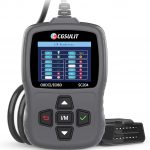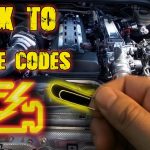The check engine light can be a source of anxiety for any driver. It’s a signal that something might be wrong with your car, but it doesn’t tell you what. While it’s always best to get your car checked by a mechanic when the check engine light comes on, there are times when you may want to clear the codes yourself. This article will guide you through the process of clearing check engine light codes and help you understand when it’s appropriate to do so.
Understanding the Check Engine Light
Before we dive into how to clear the codes, it’s important to understand what the check engine light is and what it means. The check engine light is part of your car’s onboard diagnostic system (OBD-II). This system continuously monitors various sensors and systems in your vehicle, looking for potential problems. When the OBD-II system detects an issue, it stores a diagnostic trouble code (DTC) in the car’s computer and illuminates the check engine light.
The check engine light can be triggered by a wide range of issues, from minor problems like a loose gas cap to more serious concerns like a faulty catalytic converter. In some cases, the check engine light may flash, indicating a severe problem that requires immediate attention. If you experience a flashing check engine light, it’s crucial to stop driving and have your car towed to a mechanic to prevent potential engine damage.
It’s important to note that the check engine light itself doesn’t provide specific information about the problem. However, some later car models have check engine lights with different colors and modes to help you determine how severe the issue is. A solid yellow or orange light may indicate a less severe issue, while a flashing or red light signifies a more urgent problem that requires immediate attention.
Here’s a breakdown of some common minor and major causes for the check engine light to illuminate:
Minor Causes:
- Loose Fuel Cap: A loose gas cap can allow fuel vapors to escape, triggering the check engine light.
- Spark Plug Issues: Worn or malfunctioning spark plugs can cause engine misfires, which can also trigger the light.
Major Concerns:
- Oxygen Sensor Failure: A faulty oxygen sensor can disrupt the engine’s air-fuel mixture, leading to decreased performance and increased emissions.
- Catalytic Converter Problems: The catalytic converter is a crucial component of the emissions system. If it fails, it can significantly affect engine performance and increase harmful emissions.
- Mass Airflow Sensor Malfunction: The mass airflow sensor measures the amount of air entering the engine. A malfunction can disrupt the engine’s air-fuel balance, affecting its efficiency.
When to Clear Check Engine Light Codes
While clearing the check engine light codes might seem like a quick fix, it’s important to remember that it doesn’t actually solve the underlying problem. Clearing the codes simply erases the DTCs from the car’s computer and turns off the warning light.
Here are some situations where it might be appropriate to clear check engine light codes:
After Completing Repairs
If you’ve diagnosed and repaired the issue that triggered the check engine light, you can clear the codes to confirm that the problem is resolved. This can also help prevent the light from coming back on unnecessarily.
Diagnosing Intermittent Issues
If the check engine light comes on and off intermittently, clearing the codes can help you determine if the problem is recurring. By clearing the codes and monitoring when the light comes back on, you can gather more information about the issue and potentially narrow down the cause.
Preparing for Emissions Tests
In some cases, you may need to clear the codes to ensure that your car’s OBD-II system is ready for an emissions test. However, it’s important to note that clearing the codes too close to the test may cause your car to fail. This is because the car’s computer needs time to complete its diagnostic tests (known as “monitors”) after the codes have been cleared. If the monitors are not complete, the emissions test may not be able to accurately assess the vehicle’s emissions levels.
How to Clear Check Engine Light Codes
There are a few different ways to clear check engine light codes:
1. Using an OBD2 Scanner
An OBD2 scanner is a diagnostic tool that plugs into your car’s OBD-II port and allows you to read and clear DTCs. These scanners can do much more than just read and clear codes. They can also:
- Monitor real-time data: Observe live sensor readings, such as engine RPM, vehicle speed, and coolant temperature, to get a better understanding of your car’s performance.
- Retrieve freeze frame data: Capture a snapshot of the vehicle’s system at the moment a DTC was triggered, providing valuable information for diagnosis.
- View live data streams: Observe data from multiple sensors simultaneously to diagnose complex issues that involve interactions between different systems.
- Check emissions test readiness: Determine if your vehicle is ready to pass an emissions test by checking if all the necessary monitors have been completed.
OBD2 scanners come in a variety of types, from basic code readers to advanced devices with more features. Basic code readers are typically more affordable and provide essential information about DTCs. Advanced scanners offer more comprehensive analysis, including live data monitoring, system tests, and even the ability to reprogram vehicle control modules.
To clear codes with an OBD2 scanner:
- Locate the OBD-II port: The OBD-II port is typically located under the dashboard on the driver’s side.
- Connect the scanner: Plug the scanner into the OBD-II port.
- Turn on the ignition: Turn the ignition to the “On” or “Run” position, but don’t start the engine.
- Follow the scanner’s instructions: The scanner will guide you through the process of reading and clearing codes. Typically, you’ll need to select an option like “Read Codes” or “Erase Codes.”
When you read the codes, the scanner will display a series of letters and numbers. These codes need to be deciphered to understand the diagnosis. The first letter indicates the system involved (e.g., “P” for powertrain, “B” for body, “C” for chassis, “U” for network). The following numbers provide more specific information about the fault. For example, a code like “P0171” indicates a problem with the fuel system (“P”), specifically a “System Too Lean” condition (0171). You can consult the scanner’s manual or an online database to get a more detailed explanation of each code.
2. Using a Smartphone App
Many modern OBD2 scanners are available as smartphone apps. These apps connect to your car’s computer using a cable or a Bluetooth dongle that plugs into the OBD-II port. Once connected, the app can read and clear codes, display live data, and perform other diagnostic functions, just like a traditional OBD2 scanner.
3. Disconnecting the Battery
Disconnecting the car battery for a short period can also clear check engine light codes. This method works by resetting the car’s computer, which erases the stored DTCs.
To clear codes by disconnecting the battery:
- Turn off the ignition and any accessories: Make sure the car is completely off before disconnecting the battery.
- Locate the negative battery terminal: The negative terminal is usually black and marked with a minus sign (-). It might be located on the side or top of the battery.
- Disconnect the negative terminal: Use a wrench to loosen the nut or bolt holding the negative cable to the terminal. Carefully slide the cable off the terminal and move it aside to prevent accidental contact.
- Wait 15-20 minutes: This allows the car’s computer to fully reset.
- Reconnect the battery: Reconnect the negative battery terminal and tighten the nut or bolt securely.
Keep in mind that disconnecting the battery may reset other electronic systems in your car, such as the radio, clock, and seat memory settings.
4. Driving the Vehicle
In some cases, the check engine light may turn off on its own after driving the vehicle for a few days, especially if the problem that triggered the light has been resolved. This is because the car’s computer continuously monitors the engine and emissions systems, and if it doesn’t detect any further problems, it will eventually clear the codes and turn off the light.
Preventative Maintenance with Diagnostic Tools
Car diagnostic tools, such as OBD2 scanners, can be valuable for preventative maintenance. By regularly scanning for error codes and monitoring system performance, you can detect potential issues early and address them before they become major problems. This can help prevent costly repairs and keep your car running smoothly.
Here are some ways to use diagnostic tools for preventative maintenance:
- Routine Scans: Perform periodic scans with an OBD2 scanner to check for any stored or pending codes. This can help identify potential problems before they cause noticeable symptoms.
- Scheduled Maintenance: Incorporate diagnostic scans into your car’s scheduled maintenance routine. This can help ensure that all systems are functioning correctly and identify any potential issues that may not be apparent during a visual inspection.
Important Considerations
While clearing check engine light codes can be helpful in certain situations, it’s important to remember that it’s not a substitute for proper diagnosis and repair. If the check engine light comes on, it’s always best to get your car checked by a mechanic to determine the underlying cause of the problem.
Ignoring the check engine light can lead to more serious problems and potentially costly repairs down the road. Additionally, clearing the codes can erase valuable diagnostic data that could help a mechanic identify the issue.
Common Questions About Clearing Check Engine Light Codes
Here are some common questions people have about clearing check engine light codes:
- How long does it take for a check engine light to reset? The time it takes for a check engine light to reset can vary depending on the vehicle and the nature of the problem. In some cases, the light may turn off immediately after the issue is resolved. In other cases, it may take several drive cycles for the car’s computer to clear the codes.
- Will disconnecting the battery clear all codes? Disconnecting the battery will typically clear most, if not all, of the stored DTCs. However, it may not clear codes related to more serious issues or those that require specific reset procedures.
- Can I clear the check engine light without a scanner? Yes, you can clear the check engine light by disconnecting the battery. However, using an OBD2 scanner is generally the preferred method as it allows you to read the codes and confirm that the problem is resolved.
- Is it legal to clear check engine light codes? It is generally legal to clear check engine light codes, but it’s important to ensure that you’re not doing so to mask a problem that needs to be addressed for safety or emissions compliance.
Conclusion
The check engine light is an important warning signal that should not be ignored. While clearing the codes can be helpful in certain situations, it’s crucial to understand the underlying cause of the problem and address it appropriately. OBD2 scanners are valuable tools for reading and clearing codes, as well as for preventative maintenance. By understanding how to use these tools and when to clear codes, you can take control of your car’s maintenance and ensure that it stays running smoothly. Remember to consult a professional mechanic if you’re unsure about the cause of the check engine light or how to address the problem.






